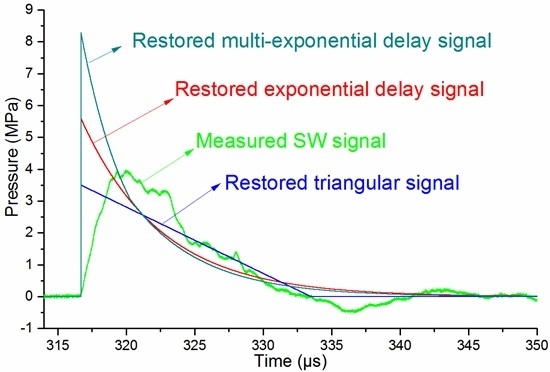Signal Analysis and Waveform Reconstruction of Shock Waves Generated by Underwater Electrical Wire Explosions with Piezoelectric Pressure Probes
Abstract
:1. Introduction
- The SW peak pressure can reach several to tens of GPa near the blast source [8,19,20,21] and tens to hundreds of MPa in the rather far field [22], so a reliable mechanical strength and proper structure are required to avert possible damage to the pressure sensors. Besides, the pressure sensors often work totally immersed in water, which calls for an impeccable waterproofing treatment.
- This ultra-wideband SW signal puts very high demands on the frequency response characteristics of pressure sensors. In order to ensure a large enough sensitivity, the sensitive element of a pressure sensor cannot be designed too small, but a finite size will stretch the wavefront due to the integrating effect. Besides, the pressure probe is often placed in water at a certain depth and inevitably connected with signal conditioning and recording devices with a rather long cable, then the long cable and the signal conditioning device will greatly distort the waveform and decrease the bandwidth.
2. Measurement System
2.1. Experimental Setup
2.2. Measurement System Consistency
2.3. Influence of Incident Angle and Sensitive Element Size
3. Analysis of Signals Obtained by PCB138 and Müller-Plate Probes
3.1. Analysis of the Peak Pressure vs. SW Propagating Distance
3.2. Analysis of the Pulse Width and Decay Time Constant
4. SW Pressure Evaluation and Reconstruction
4.1. Peak Pressure Evaluation with the TOF Method
4.1.1. SW Pressure Measurement Principle Based on the TOF Method
4.1.2. Feasibility of Peak Pressure Evaluation with the TOF Method in Practical Application
4.2. Reconstruction of the Real Pressure Waveform with the Energy Conservation Method
4.2.1. Waveform Reconstruction Criteria
4.2.2. Three Kinds of SW Waveform Models
4.2.3. Waveform Reconstruction Process
- (1)
- A series of peak pressure Ppeak, pulse width Δt and time constant τ were assumed in a rather large value range, so SW waveforms with different parameters could be obtained with Equations (13)–(15).
- (2)
- FFT calculations were performed, and the magnitude error ErrorP and the relative error ErrorP were calculated with Equation (12).
- (3)
- The proper peak pressure Ppeak, pulse width Δt and time constant τ could be picked up with the pre-set threshold values of both ErrorP and ErrorE, and the real SW signal can be obtained.
4.2.4. Typical SW Reconstruction Results
4.2.5. Verification of the Reconstruction Results
4.2.6. Discussion
5. Conclusions
Acknowledgments
Author Contributions
Conflicts of Interest
References
- Pu, Y.; Manousakas, I.; Liang, S.; Chang, C. Design of the Dual Stone Locating System on an Extracorporeal Shock Wave Lithotriptor. Sensors 2013, 13, 1319–1328. [Google Scholar] [CrossRef] [PubMed]
- Golovashchenko, S.F.; Gillard, A.J.; Mamutov, A.V. Formability of dual phase steels in electrohydraulic forming. J. Mater. Process. Technol. 2013, 213, 1191–1212. [Google Scholar] [CrossRef]
- Watanabe, T.; Maehara, H.; Oda, A.; Itoh, S. Effect of shock loading on food processing. In Proceedings of the ASME 2006 Pressure Vessels and Piping/ICPVT-11 Conference, Vancouver, BC, Canada, 23–27 July 2006; pp. 313–318.
- Toepfl, S.; Heinz, V.; Knorr, D. High intensity pulsed electric fields applied for food preservation. Chem. Eng. Process. Process Intensif. 2007, 46, 537–546. [Google Scholar] [CrossRef]
- Maurel, O.; Reess, T.; Matallah, M.; De Ferron, A.; Chen, W.; La Borderie, C.; Pijaudier-Cabot, G.; Jacques, A.; Rey-Bethbeder, F. Electrohydraulic shock wave generation as a means to increase intrinsic permeability of mortar. Cement. Concrete Res. 2010, 40, 1631–1638. [Google Scholar] [CrossRef]
- Chen, W.; Maurel, O.; Reess, T.; De Ferron, A.S.; La Borderie, C.; Pijaudier-Cabot, G.; Rey-Bethbeder, F.; Jacques, A. Experimental study on an alternative oil stimulation technique for tight gas reservoirs based on dynamic shock waves generated by Pulsed Arc Electrohydraulic Discharges. J. Petrol. Sci. Eng. 2012, 88/89, 67–74. [Google Scholar] [CrossRef]
- Fedotov-Gefen, A.V.; Krasik, Y.E. Polarimetry and Schlieren diagnostics of underwater exploding wires. J. Appl. Phys. 2009, 106, 933–941. [Google Scholar] [CrossRef]
- Grinenko, A.; Efimov, S.; Fedotov, A.; Krasik, Y.E.; Schnitzer, I. Efficiency of the shock wave generation caused by underwater electrical wire explosion. J. Appl. Phys. 2006, 100, 113–119. [Google Scholar] [CrossRef]
- Wei, W.; Li, X.; Wu, J.; Yang, Z.; Jia, S.; Qiu, A. Interferometric and schlieren characterization of the plasmas and shock wave dynamics during laser-triggered discharge in atmospheric air. Phys. Plasmas 2014, 21, 83–112. [Google Scholar] [CrossRef]
- Oshita, D.; Hosseini, S.H.R.; Mawatari, K.; Nejad, S.M.; Akiyama, H. Two Successive Shock Waves Generated by Underwater Pulse Electric Discharge for Medical Applications. IEEE Trans Plasma Sci. 2014, 42, 3209–3214. [Google Scholar] [CrossRef]
- Pangilinan, G.I.; Russell, T.P.; Baer, M.R.; Namkung, J.; Chambers, P. Underwater shock measurements using a ruby pressure gauge. Appl. Phys. Lett. 2000, 77, 684–686. [Google Scholar] [CrossRef]
- Yiannakopoulos, G. A Review of Manganin Gauge Technology for Measurements in the Gigapascal Range; MRL-TR-90–5; National Aeronautics and Space Administration: Adelaide, Australia, 1990.
- Sayapin, A.; Grinenko, A.; Efimov, S.; Krasik, Y.E. Comparison of different methods of measurement of pressure of underwater shock waves generated by electrical discharge. Shock Waves 2006, 15, 73–80. [Google Scholar] [CrossRef]
- Ginsberg, M.J.; Asay, B.W. Commercial carbon composition resistors as dynamic stress gauges in difficult environments. Rev. Sci. Instrum. 1991, 62, 221–228. [Google Scholar] [CrossRef]
- Tussing, R.B. Accuracy and Response of Tourmaline Gages for Measurement of Underwater Explosion Phenomena; NSWC TR 82-294; Naval Surface Weapons Center: Potomac, ML, USA, 1982. [Google Scholar]
- Shirinov, A.V.; Schomburg, W.K. Pressure sensor from a PVDF film. Sens. Actuators A Phys. 2008, 142, 48–55. [Google Scholar] [CrossRef]
- Bauer, F. PVDF shock sensors: Applications to polar materials and high explosives. IEEE Trans. Ultrason. Ferroelectr. Freq. Control 2000, 47, 1448–1454. [Google Scholar] [CrossRef] [PubMed]
- Zhang, X. Research on Uncertainty of Underwater Explosion Pressure Measurement. Ph.D. Thesis, China Ship Research & Development Academy, Beijing, China, 2014. [Google Scholar]
- Ning, J.; Wang, C.; Ma, T. Explosion and Shock Dynamics; National Defense Industry Press: Beijing, China, 2012. [Google Scholar]
- Grinenko, A.U.; Sayapin, A.F.; Efimov, S.V.; Gurovitch, V.T.; Krasik, Y.E.; Oreshkin, V.I. Experimental and theoretical study of strongly coupled copper plasma generated by underwater electrical wire explosion. Dense Z-Pinches 2006, 808, 91–94. [Google Scholar]
- Grinenko, A.; Gurovich, V.T.; Krasik, Y.E.; Sayapin, A.; Efimov, S.; Felsteiner, J. Analysis of shock wave measurements in water by a piezoelectric pressure probe. Rev. Sci. Instrum. 2004, 75, 24–30. [Google Scholar] [CrossRef]
- Cole, R.H. Underwater Explosion; Princeton University Press: Princeton, NJ, USA, 1948. [Google Scholar]
- Zhou, H.; Han, R.; Liu, Q.; Jing, Y.; Wu, J.; Zhang, Y.; Qiu, A.; Zhao, Y. Generation of Electrohydraulic Shock Waves by Plasma-Ignited Energetic Materials: II. Influence of Wire Configuration and Stored Energy. IEEE Trans. Plasma Sci. 2015, 43, 4009–4016. [Google Scholar] [CrossRef]
- Zhou, H.; Zhang, Y.; Li, H.; Han, R.; Jing, Y.; Liu, Q.; Wu, J.; Zhao, Y.; Qiu, A. Generation of Electrohydraulic Shock Waves by Plasma-Ignited Energetic Materials: III. Shock Wave Characteristics with Three Discharge Loads. IEEE Trans. Plasma Sci. 2015, 43, 4017–4023. [Google Scholar] [CrossRef]
- Li, X.; Chao, Y.; Wu, J.; Han, R.; Zhou, H.; Qiu, A. Study of the shock waves characteristics generated by underwater electrical wire explosion. J. Appl. Phys. 2015, 118. [Google Scholar] [CrossRef]
- Han, R.; Zhou, H.; Liu, Q.; Wu, J.; Jing, Y.; Chao, Y.; Zhang, Y.; Qiu, A. Generation of Electrohydraulic Shock Waves by Plasma-Ignited Energetic Materials: I. Fundamental Mechanisms and Processes. IEEE Trans. Plasma Sci. 2015, 43, 3999–4008. [Google Scholar] [CrossRef]
- Zhou, Q.; Zhang, Q.; Zhang, J.; Zhao, J.; Pang, L.; Ren, B. Effect of Circuit Parameters and Wire Properties on Exploding a Copper Wire in Water. IEEE Trans. Plasma Sci. 2011, 39, 1606–1612. [Google Scholar] [CrossRef]
- Stelmashuk, V.; Hoffer, P. Shock Waves Generated by an Electrical Discharge on Composite Electrode Immersed in Water With Different Conductivities. IEEE Trans. Plasma Sci. 2012, 40, 1907–1912. [Google Scholar] [CrossRef]
- Hess, G.R. Plasma Driven Water Shock; Defense Nuclear Agency: Alexander, VA, USA.
- Costanzo, F.A. Underwater Explosion Phenomena and Shock Physics. In Structural Dynamics; Springer: Berlin, Germany, 2011; pp. 917–938. [Google Scholar]
- Ushakov, V.Y.; Klimkin, V.F.V.C.; Korobeynikov, S.M. Impulse Breakdown of Liquids; Springer Science\& Business Media: Berlin, Germany, 2007. [Google Scholar]
- Grinenko, A.; Sayapin, A.; Gurovich, V.T.; Efimov, S.; Felsteiner, J.; Krasik, Y.E. Underwater electrical explosion of a Cu wire. J. Appl. Phys. 2005, 97. [Google Scholar] [CrossRef]
- Shafer, D.; Toker, G.R.; Gurovich, V.T.; Gleizer, S.; Krasik, Y.E. Peculiarity of convergence of shock wave generated by underwater electrical explosion of ring-shaped wire. Phys. Plasmas 2013, 20. [Google Scholar] [CrossRef]
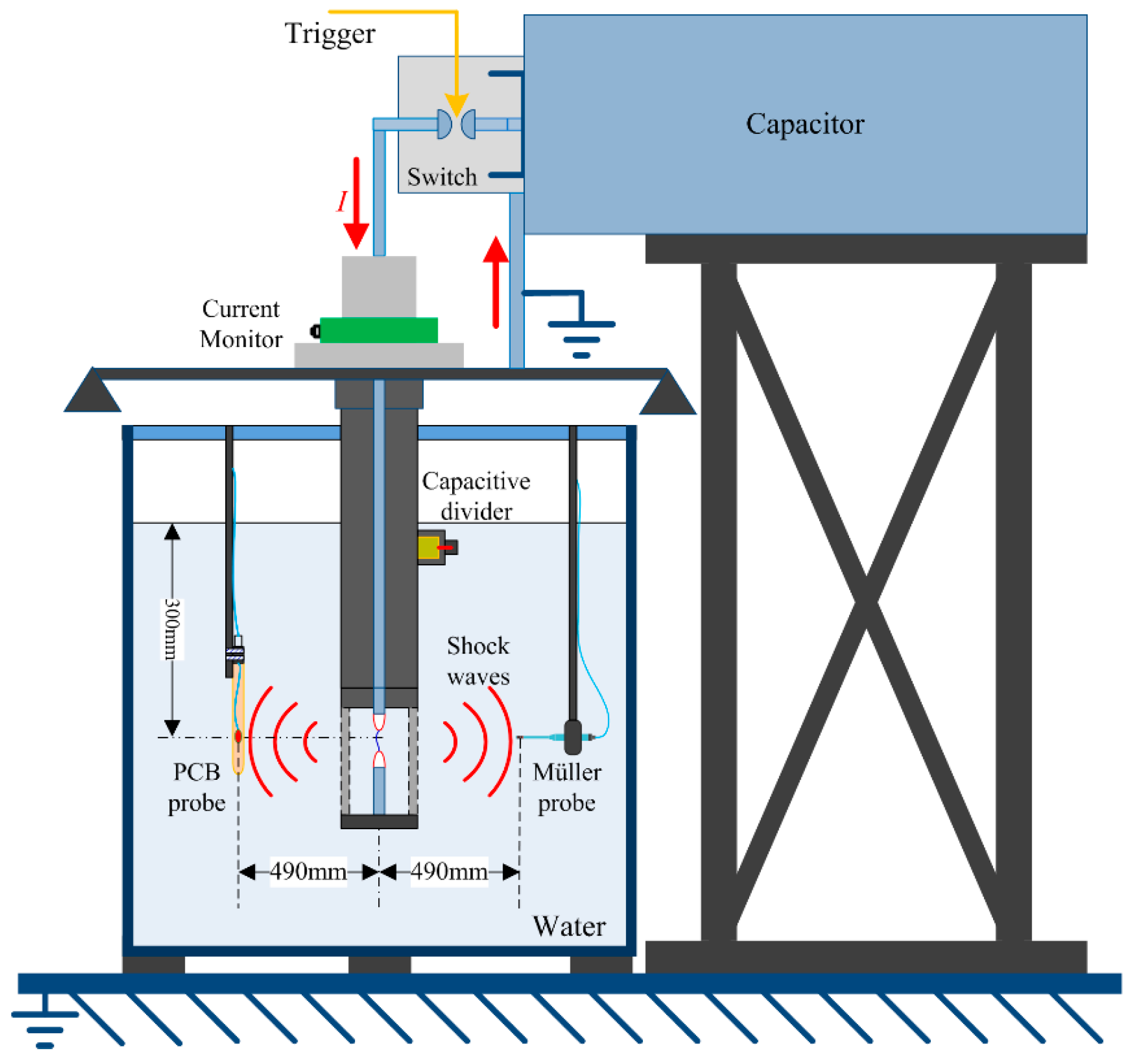
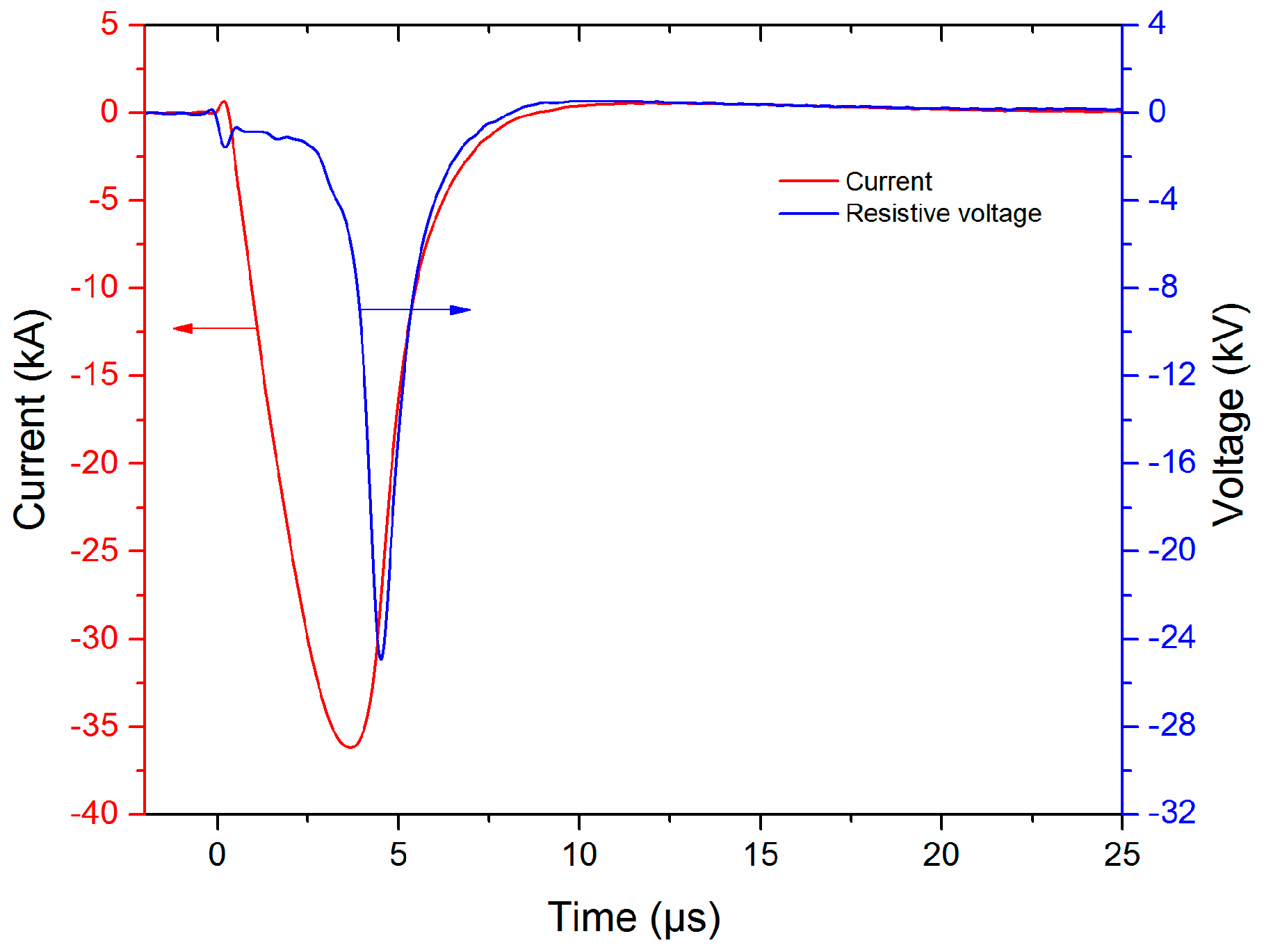
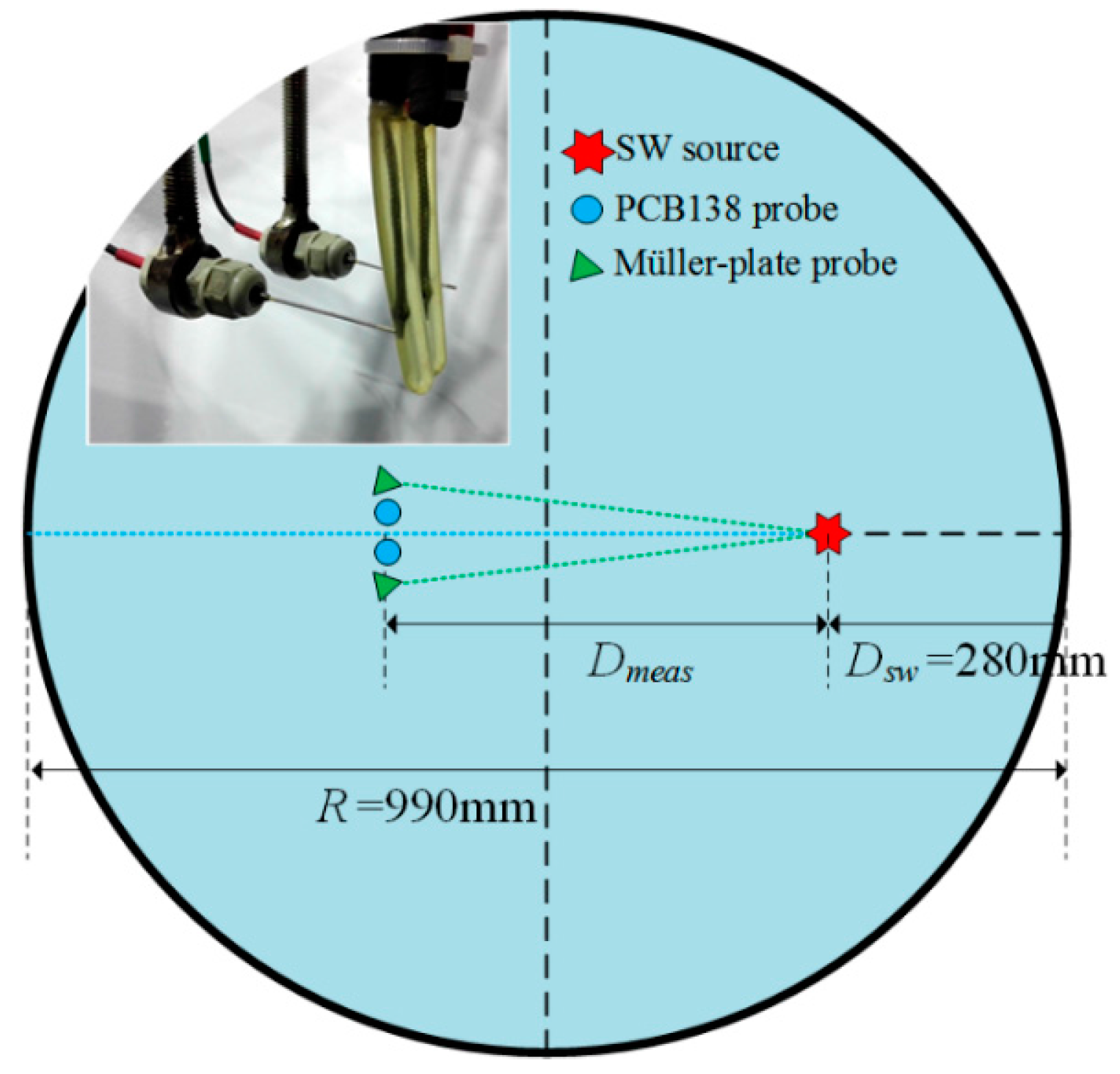




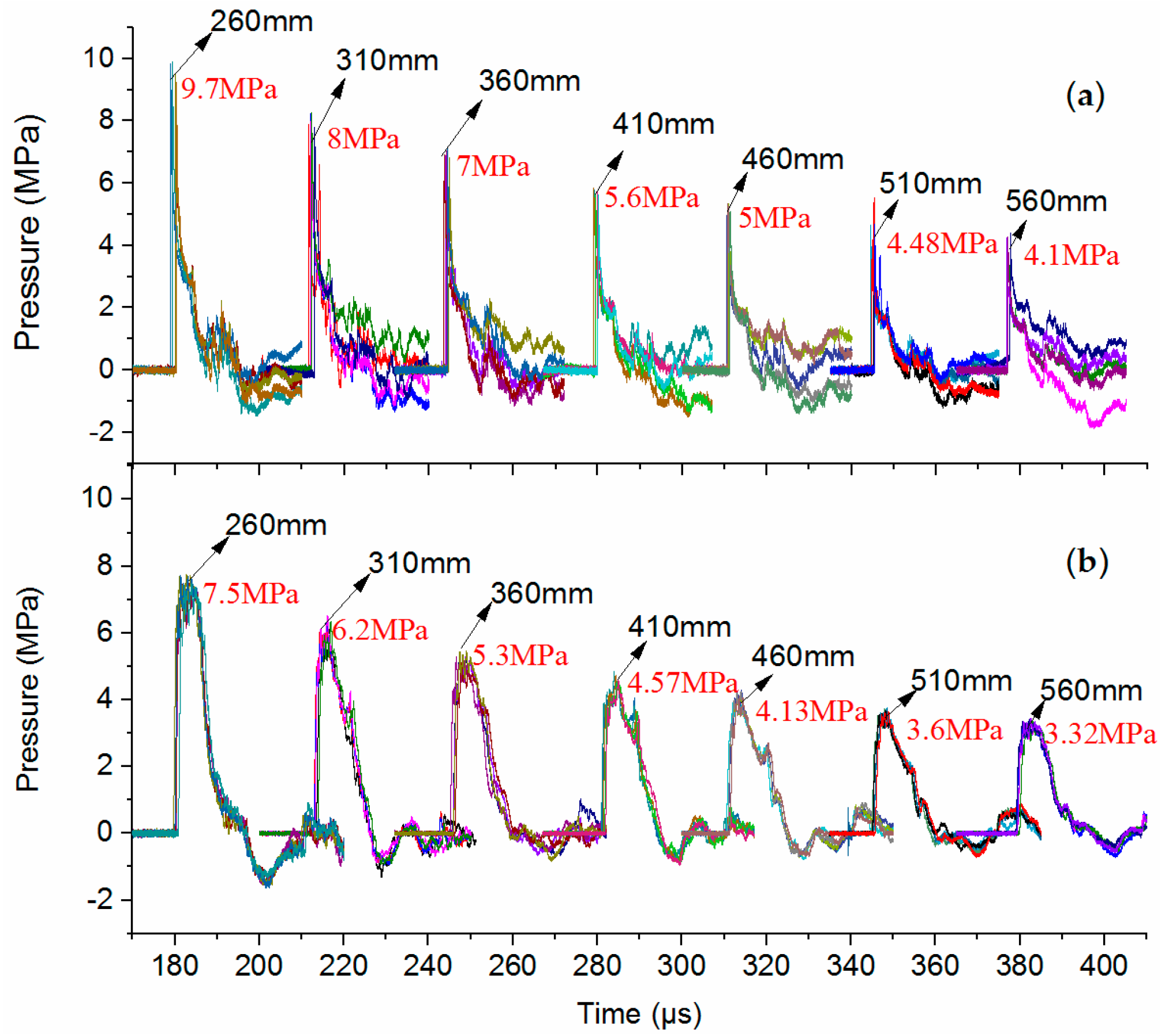
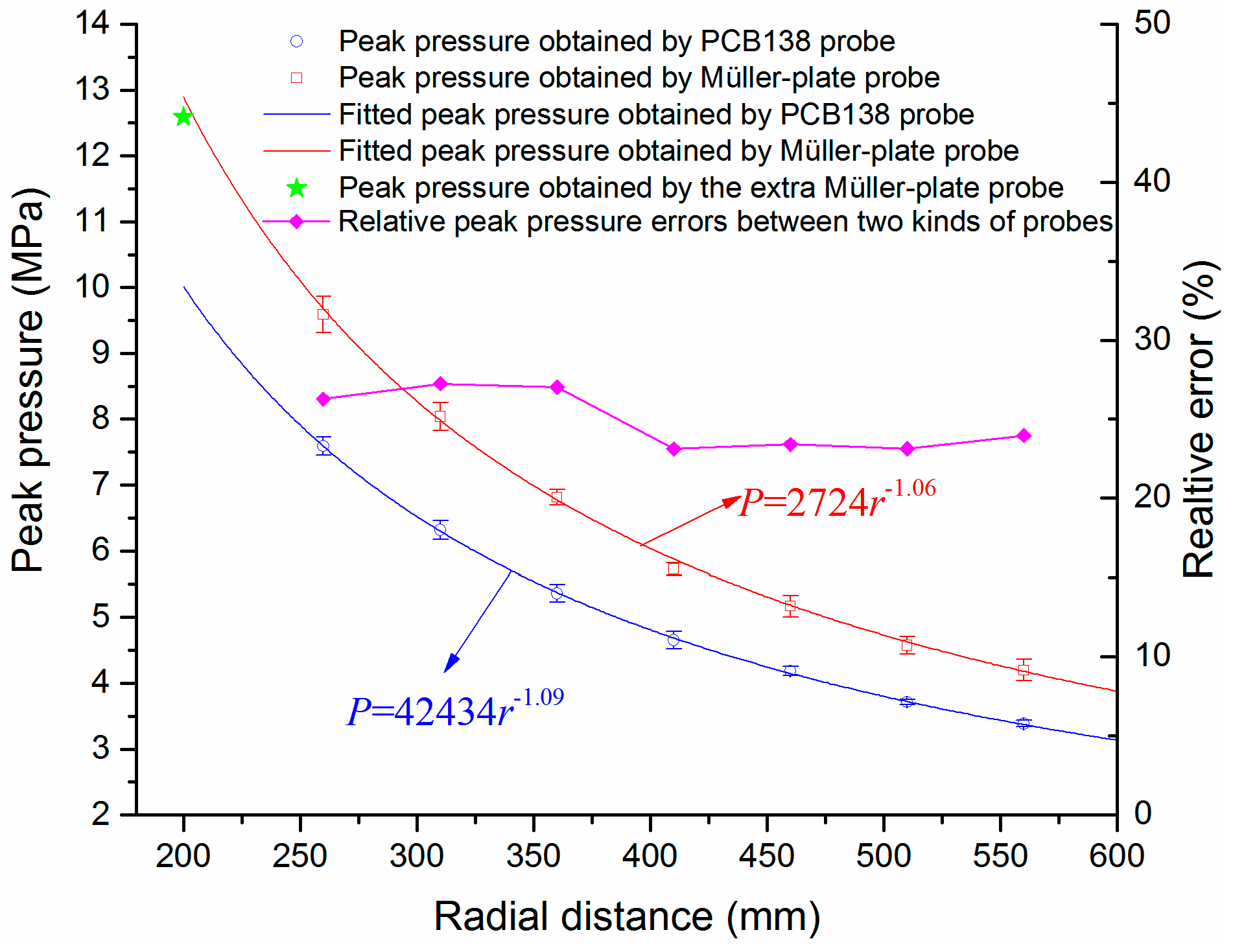
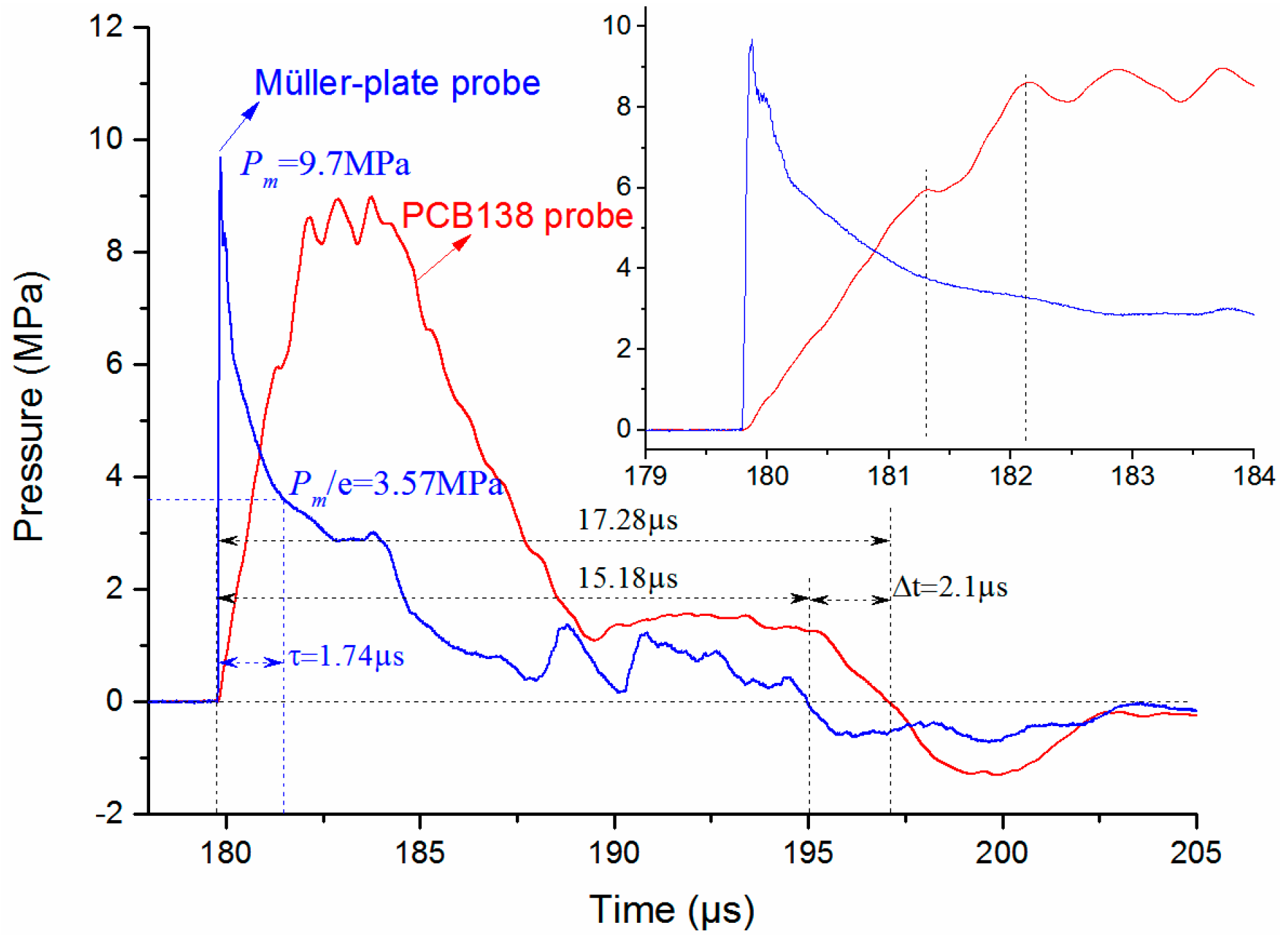
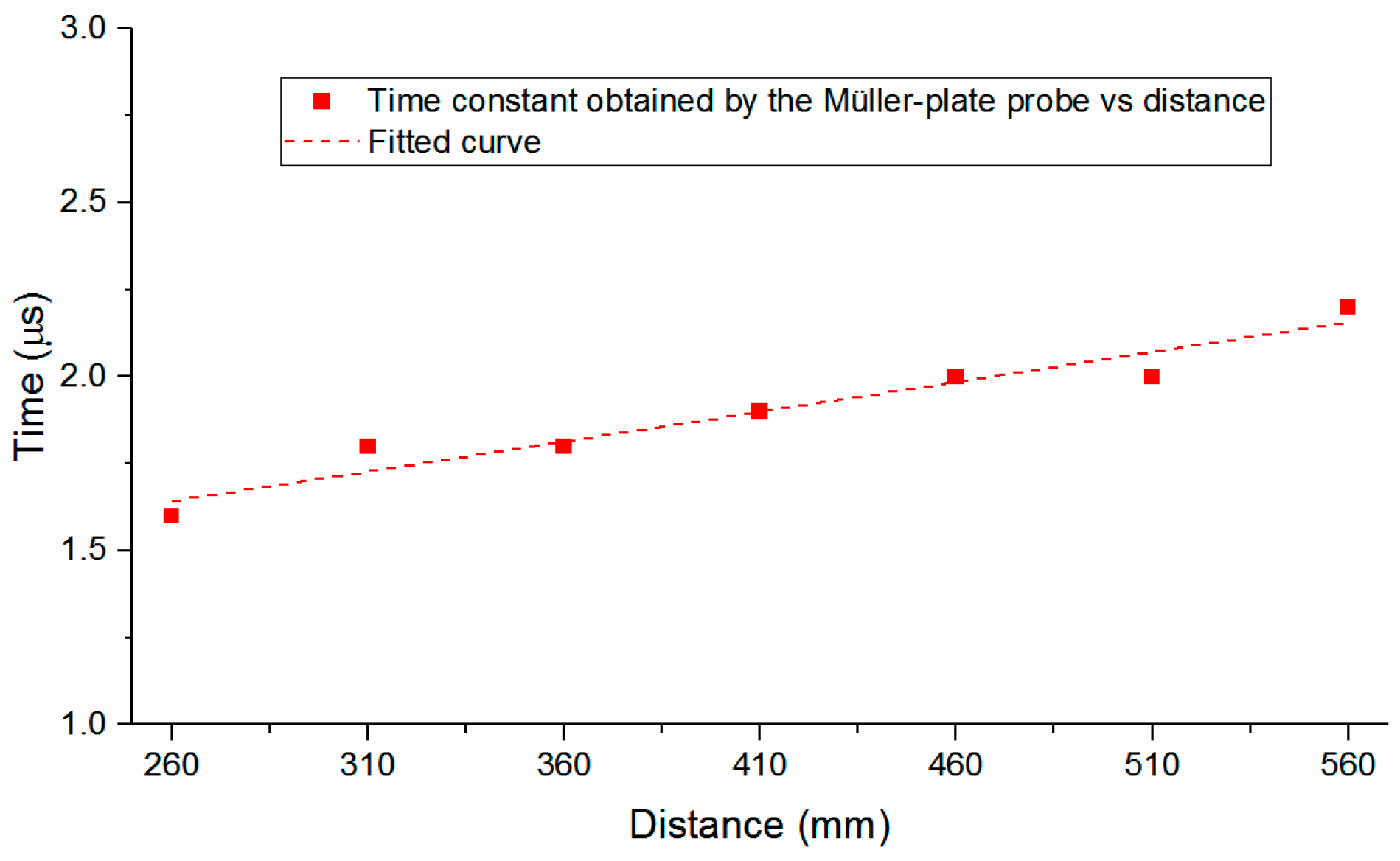

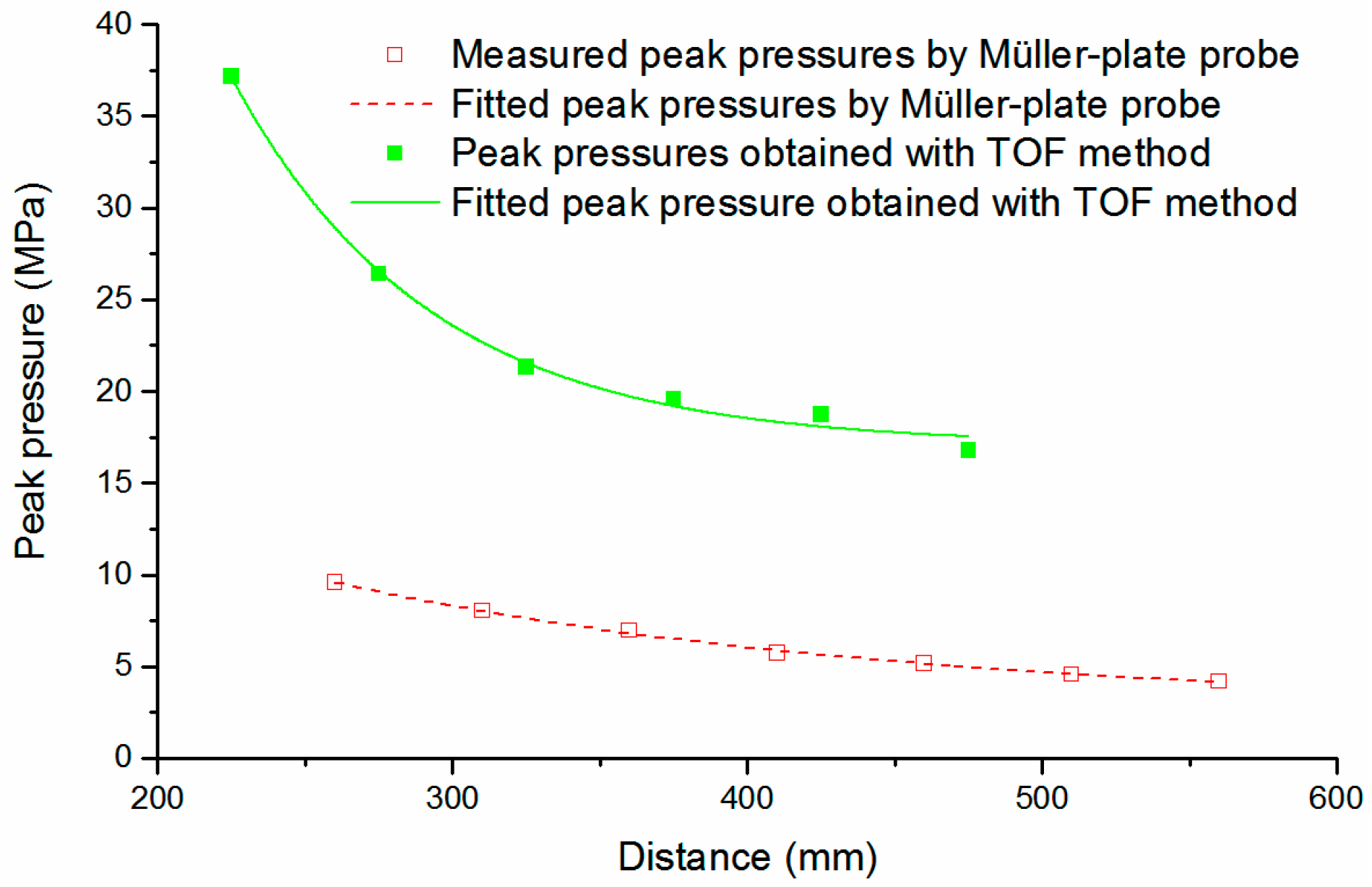
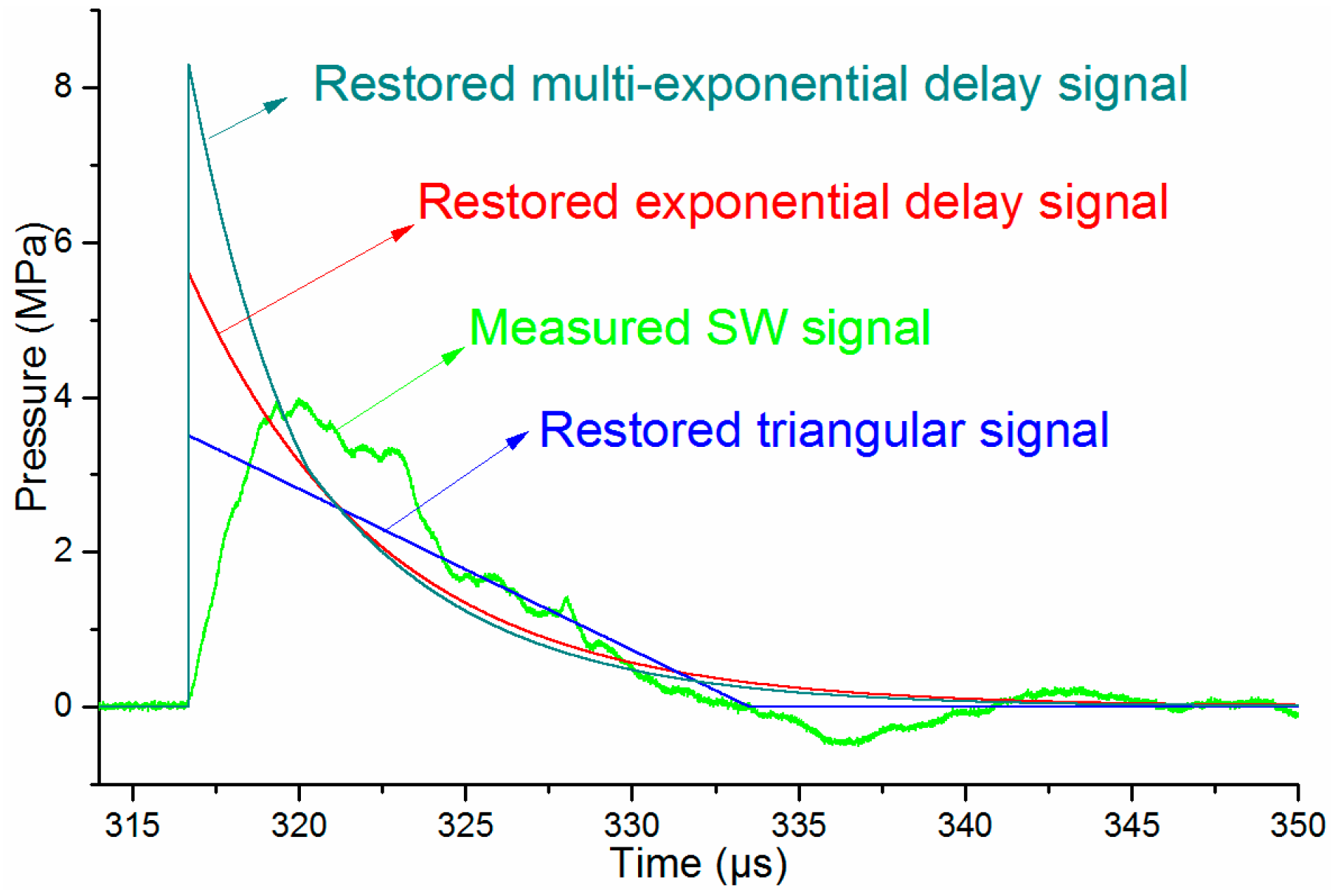
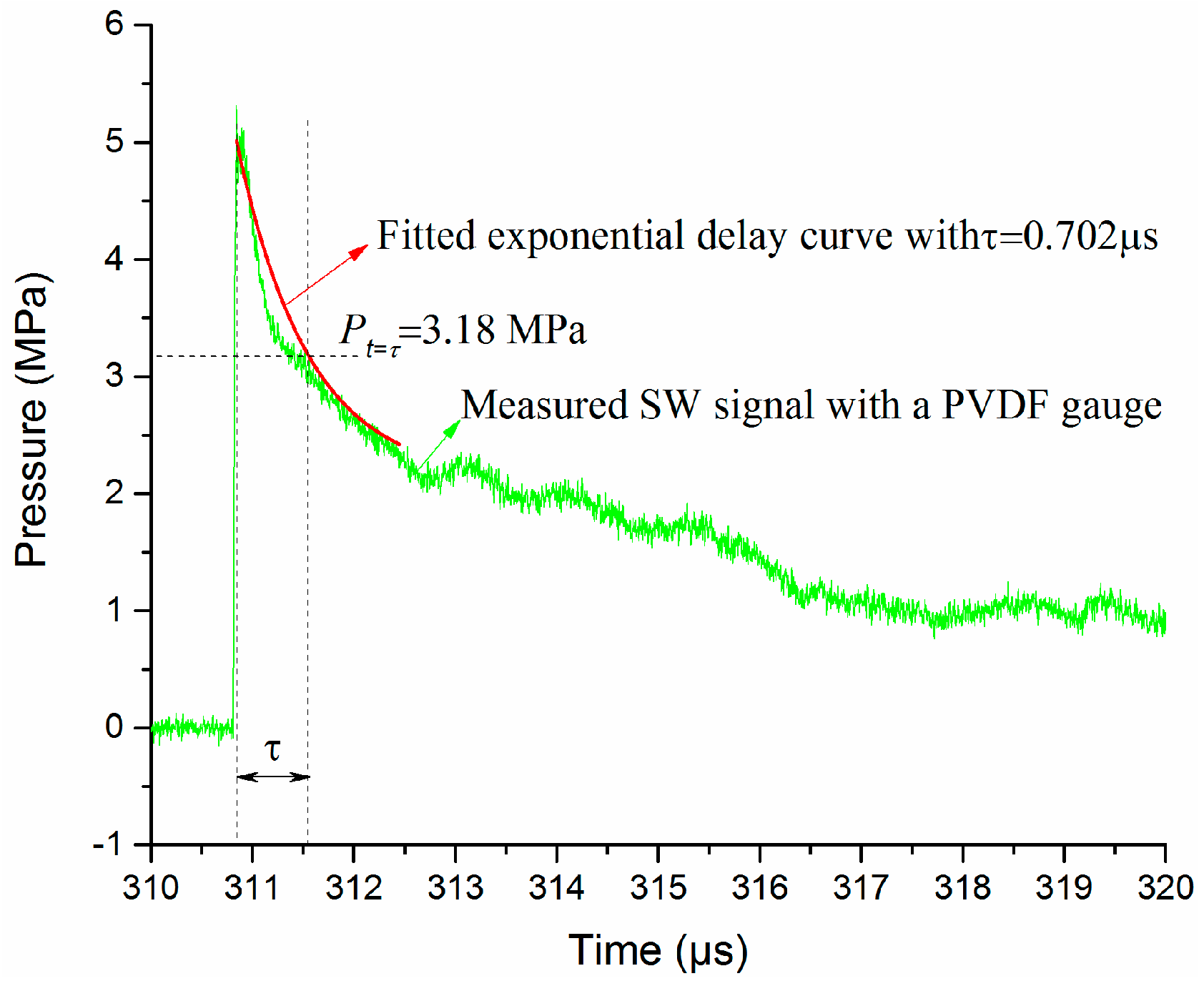
| Parameters | PCB138A11 | Müller-Plate Needle Hydrophone |
|---|---|---|
| Sensitive element type | Tourmaline | PVDF |
| Sensitive element size | ~Φ3.2 mm × 1 mm (measured) | <Φ0.5 mm |
| Sensitivity uncertainty | ±15% | - |
| Rise time | <1.5 μs | <50 ns |
| Bandwidth | 2.5–1 MHz | 0.3–11 MHz |
| Cable length | 20 m | 2 m |
| Parameters | PCB138 Probe | Müller-Plate Probe | ||
|---|---|---|---|---|
| Peak Pressures | Arrival Times | Peak Pressures | Arrival Times | |
| Mean value | 8.87 MPa | 179.91 μs | 9.70 MPa | 179.80 μs |
| Standard deviation | 0.136 MPa | 0.460 μs | 0.196 MPa | 0.427 μs |
| Coefficient of variance | 1.5% | 0.26% | 2.0% | 0.24% |
© 2016 by the authors; licensee MDPI, Basel, Switzerland. This article is an open access article distributed under the terms and conditions of the Creative Commons Attribution (CC-BY) license (http://creativecommons.org/licenses/by/4.0/).
Share and Cite
Zhou, H.; Zhang, Y.; Han, R.; Jing, Y.; Wu, J.; Liu, Q.; Ding, W.; Qiu, A. Signal Analysis and Waveform Reconstruction of Shock Waves Generated by Underwater Electrical Wire Explosions with Piezoelectric Pressure Probes. Sensors 2016, 16, 573. https://doi.org/10.3390/s16040573
Zhou H, Zhang Y, Han R, Jing Y, Wu J, Liu Q, Ding W, Qiu A. Signal Analysis and Waveform Reconstruction of Shock Waves Generated by Underwater Electrical Wire Explosions with Piezoelectric Pressure Probes. Sensors. 2016; 16(4):573. https://doi.org/10.3390/s16040573
Chicago/Turabian StyleZhou, Haibin, Yongmin Zhang, Ruoyu Han, Yan Jing, Jiawei Wu, Qiaojue Liu, Weidong Ding, and Aici Qiu. 2016. "Signal Analysis and Waveform Reconstruction of Shock Waves Generated by Underwater Electrical Wire Explosions with Piezoelectric Pressure Probes" Sensors 16, no. 4: 573. https://doi.org/10.3390/s16040573





